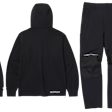
Just as construction equipment needs to be prepared to transition to winter, so too does a worker’s wardrobe.
As OSHA notes on its winter weather website, the seasonal transition calls for construction workers to plan, equip and train to prevent illnesses, injuries, and fatalities during winter storms.
The agency noted colder temperatures can expose outdoor workers to frostbite, hypothermia, and cold stress, all of which can be fatal. Cold stress symptoms include reddening skin, tingling, pain, swelling, leg cramps, numbness, and blisters.
This IRONPROS story elaborates on the topic.
Know the wind chill temperature to better prepare and perform work safely. Making it a habit to check the forecast before a work shift to make informed apparel choices. For more safety tips, visit OSHA’s Winter Weather page.
Among the best management practices to help with the seasonal shift is to plan to dress in layers, adjusting layers in response to temperature fluctuations.
The base layer should be made of moisture-wicking fabrics like polyester or merino wool to keep sweat off the skin. Flannel and fleece offer warmth. More information on wearing wool can be found in this IRONPROS story.
A good mid-layer choice would be a fleece or insulated vest that doesn’t restrict movement.
The outer layer – a parka, jacket, coveralls, or overalls – also should be insulated and can be waterproof and windproof.
As this IRONPROS story notes, cotton should be avoided in the cooler months – when it gets wet, it loses its insulative properties.
It’s also the season to consider layering pants as well. A base layer for cargo pants and work pants can include long underwear, thermal underwear, leggings, and long johns, as this IRONPROS story notes.
The value of thermoregulating fabrics is noted in this IRONPROS story on breathable work pants. The self-regulating fabric from infrared-sensitive yarn reacts to temperature and humidity. When the microenvironment between a person’s skin and the garment changes, the strands constrict to vent more heat—or expand to hold that warmth closer to the body.
The neck and head can be protected with insulated head gear such as beanies and balaclavas. Face masks and gaiters help protect against the elements.
This IRONPROS story delves into the proper eyewear to have on hand to prevent snow blindness.
This IRONRPROS story addresses how the best insulation for work gloves includes fleece, Thinsulate, PrimaLoft and synthetics. Some gloves come with a cold rating indicating under what temperatures the gloves can best operate.
The outer shell should be manufactured from durable and abrasion-resistant material such as leather. Synthetic materials such as nylon or polyester offer a high level of water resistance and are lighter in weight. Rubber is another option.
Windproof gloves add an extra layer of warmth retention in windier conditions. Breathability is a key factor to prevent moisture buildup inside the gloves and prevent sweating as sweating hands can quickly get cold.
Another option is heated gloves, equipped with heating elements typically powered by rechargeable lithium-ion batteries which generate heat to keep hands warm.
The fall transition also entails wearing boots insulated with wool lining or Thinsulate. Boots should be waterproof and have slip-resistant soles for working on wet or icy surfaces.
Opting for merino wool socks is a consideration during the fall transition, as noted in this IRONPROS story. Heated socks is one option, as outlined in this IRONPROS story.
Heated socks are a wearable technology offering temporary improved blood circulation (poor circulation is a driving factor in feet feeling cold); reduced pain that may occur from cold feet; prevention of cold-related injuries such as frostbite, and increased productivity.
Heated socks can be bulkier and should be tried on with the shoes or boots being worn on the job to assess fit and comfort. Lightly padded socks would be a preferable option. Socks can be layered as well, such as using moisture-wicking socks under wool socks.
While the weather is getting colder, it’s still important to stay hydrated.
OSHA advises workers to stay dry and pack extra clothes; moisture can increase heat loss from the body. Take breaks throughout the day in warm, dry areas to prevent health issues.
Consult the jobsite’s safety manager to ensure apparel choices meet safety standards.
















